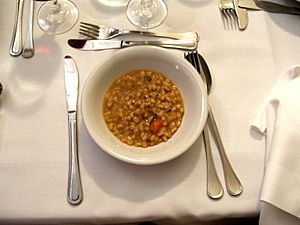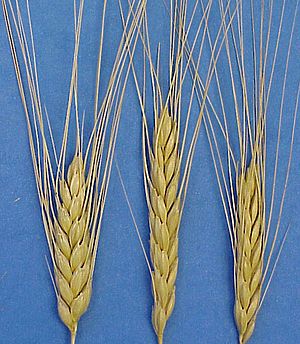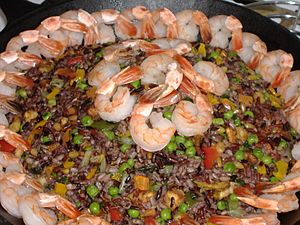Farro facts for kids

Farro is a type of grain that comes from three different kinds of wheat. People usually buy it dried, then cook it in water until it's soft. You can eat farro by itself, or you can add it to tasty dishes like salads and soups. It's a bit like rice or pasta, but with a unique chewy texture!
Contents
What is Farro?
Farro is a special name for three types of wheat that still have their outer husks on. These husks are hard to remove, even after harvesting. These three types are:
- Spelt (Triticum spelta)
- Emmer (Triticum dicoccum)
- Einkorn (Triticum monococcum)
In Italy, where farro is very popular, people sometimes call these types by different names:
- Farro grande (big farro) for spelt
- Farro medio (medium farro) for emmer
- Farro piccolo (small farro) for einkorn
Which Farro is Most Common?
Emmer is the most common type of farro grown in Italy. You'll find it especially in the mountain areas of Tuscany and Abruzzo. Many people think emmer is the best for cooking. That's why it's often called "true" farro.
Spelt, another type of farro, is more often grown in countries like Germany, Austria, and Switzerland.
Why is Farro Confusing?
Sometimes, people get confused about what "farro" means. This is because the names for wheat types have changed over time. Also, different regions might use the word "farro" to mean only one specific type of wheat. For example, in a place called Garfagnana in Tuscany, "farro" usually means emmer.
Some English speakers also think "farro" is just a dish made from cooked grains, not the grains themselves. Plus, farro is sometimes wrongly called "spelt" in English. But remember, "farro" actually includes all three grains: emmer, einkorn, and spelt!
Where Does the Word "Farro" Come From?
The Italian word farro comes from an old Latin word, farrum. This word meant a type of wheat. The Latin word far also gave us the word "farina," which is a type of flour.
The very old root of the word far is *bʰar-es-. This ancient word also led to other words like "barley" in English and "flour" in Old Church Slavonic. It's cool how words travel through history!



